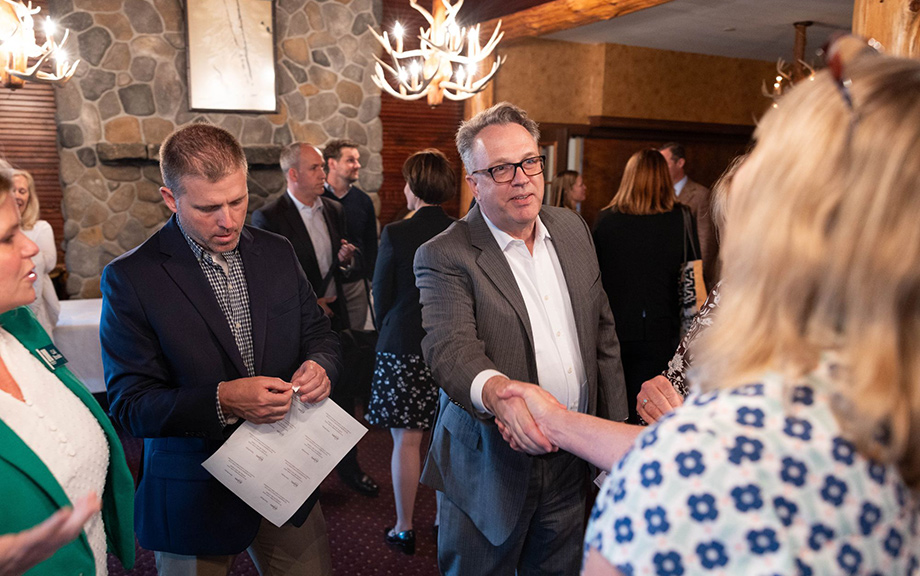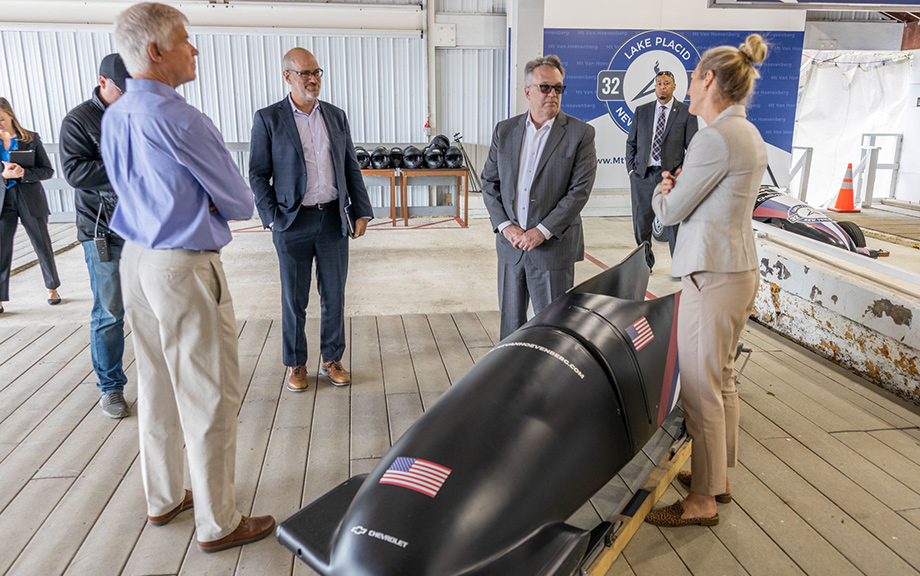
New York Fed President John C. Williams traveled to the North Country region of upstate New York last month to hear from stakeholders about local economic conditions. He met with government officials, business owners, veterans and military families, and nonprofit and community leaders during this two-day Second District regional visit.
The North Country, which consists of seven of the northernmost counties of New York State, is a vast, mostly rural landscape that accounts for nearly a quarter of the state’s landmass but just 2 percent of its population. The region shares an extensive border with Canada and encompasses the Adirondack Park, communities such as Plattsburgh and Watertown, and the U.S. Army’s Fort Drum military base.
Here are themes that emerged over two days of meetings and discussions:
Regional Relationship to Canada
The city of Plattsburgh is about 60 miles south of Montreal, Canada, and municipal officials stressed the importance of cross-border trade for the region’s economy. Stakeholders in Plattsburgh have leveraged the region’s expertise in transportation equipment manufacturing and proximity to the province of Quebec to encourage foreign direct investment, fill workforce gaps, and bolster the local economy. Further, road signs around Plattsburgh feature both English and French, highlighting the city’s unofficial designation as “Montreal’s U.S. suburb,” while city officials quipped, “we’re in the business of Quebec.”
Housing
We heard concerns about housing supply and affordability repeatedly across the region, though factors driving the difficult market conditions varied by community.
Municipal officials in Plattsburgh cited a lack of workforce housing as a top threat to economic growth. Plattsburgh is the only state-certified “Pro-Housing Community” in Clinton County, yet demand continues to outpace supply, with 4,000 more units needed locally. Factors driving housing shortages include older zoning and land use codes, high costs for materials and financing, labor shortages, and lower profit margins on low- and middle-income housing, which serve as a disincentive to new construction.

In Lake Placid, local full-time workers often find themselves priced out of the housing market due to the growing prevalence of second homeowners and short-term rentals. In an effort to build workforce housing for middle-income families in Lake Placid who do not qualify for government subsidies, one program uses donated land and sells modular homes to buyers at cost. These new homeowners—who might be teachers, healthcare workers, or first responders—must agree to a set of conditions to keep the homes affordable for future buyers.
Elsewhere, economic development officials in Watertown say home and rental prices can be boosted by landlords who capitalize on the military community by factoring soldiers’ housing stipends into the rates they charge. Further, demand continues to outpace supply, as only a third of service members stationed at Fort Drum live on base, officials said. The challenging climate is also an impediment to construction, with one stakeholder noting that, “if a house is not built by the late fall, it will not be worked on again until late spring.”
Labor Shortages
Stakeholders throughout the region consistently emphasized that a lack of affordable housing has contributed to labor shortages by making it difficult to attract and retain employees due to the long distances workers must travel to get to work. With limited public transportation options in the region, workers are further squeezed by the financial burden of owning and maintaining a vehicle, and a lack of options for childcare. Labor shortages in the region are compounded by stagnant population growth and an aging population. In light of looming retirements, stakeholders noted the need for assistance with business succession planning to support the commercial future of the region.
In order to address workforce shortages, BETA Technologies, an electric aerospace manufacturer, aims to attract talent from top universities by offering competitive benefits. The firm has introduced creative ideas such as free flight lessons for employees and flexibility around bringing children or pets to the office. The firm also has partnered with a local technical school to develop a pipeline of aerospace painters. This model reflects a larger movement in the region toward reliance on vocational schools for workforce development as local community colleges and universities face declining enrollments.
Honoring an Olympic Legacy
Lake Placid hosted the Winter Olympic Games in 1932 and again in 1980, making the community a major sports tourism destination. During a visit to the Olympic Sliding Center, stakeholders detailed plans to position the complex for future growth by honoring Lake Placid’s legacy of competitive sport. The Olympic Regional Development Authority (ORDA) has leveraged New York State’s investment in the transformation and modernization of facilities and infrastructure by making Lake Placid a year-round hub for events, athlete training, and recreation, while also focusing on sustainability amid increasing climate variability.

Life On and Off the Military Base
Fort Drum is the largest U.S. military installation east of the Mississippi and is New York State’s largest single site employer. The base focuses on military training and deployments. During a six-month period last year, approximately 25,000 service members were trained on-site, according to military officials, and the base is able to rapidly deploy 5,000 service members in five days. Fort Drum is unique among military bases in that it does not operate its own hospital or schools, and instead relies on nearby municipalities, including Watertown, to provide these services. Leaders described the integration between the base and community as a win-win, noting that retired military and their family members fill some workforce needs, while the community benefits from local spending of military pay and the use of local contractors for operations and improvements.
President Williams met with veterans and military families in Watertown to learn about life on and off the base. Participants noted the difficulty of finding jobs that match well with military leadership skills and the challenges of migrating particular talents and communication styles to the civilian sector. They also noted the importance of their supplemental military income due to low wages in the local economy. Job seekers also encounter significant competition in the local job market and find it difficult to break in because many hires are relationship-based. And some noted that military retirees often either take on debt or leave the area given the conditions they face in the labor market.
Looking Ahead
The North Country’s geography and low population density combine to create unique challenges in the delivery of essential social and municipal services. As a result, many nonprofit leaders serve many roles and rely on community partnerships and personal relationships to meet the needs of their constituents.
Despite these challenges, stakeholders are optimistic about the future of the North Country. The region’s assets, including an abundance of land, its proximity to Canada, a robust military connection, and tourism and recreation opportunities—together with investment from New York State—leave it well positioned for future growth.
Andrea Grenadier is an associate director of external engagement in the Communications and Outreach Group at the New York Fed.
Craig Bradstock is a business operations specialist in the Communications and Outreach Group at the New York Fed.
The views expressed in this article are those of the contributing authors and do not necessarily reflect the position of the New York Fed or the Federal Reserve System.










